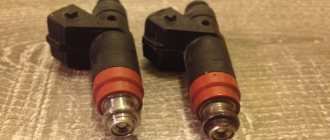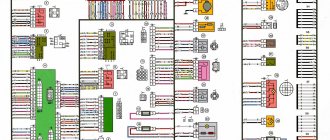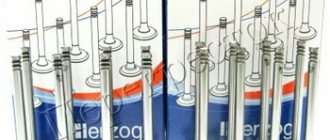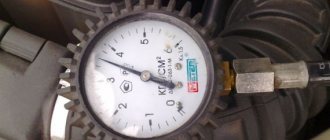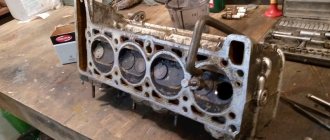Purpose of the device
Thermostat for VAZ-2114 car
Essentially, a thermostat is a large valve whose task is to allow (or, conversely, not to allow) coolant into the car radiator . When the car's engine has just started, it remains cold for some time, as does the coolant. During this period of time, the thermostat valve is closed, so that the coolant is directed in the so-called small circle. And when the engine temperature reaches 90°C, the valve in the device automatically opens and the coolant begins to circulate in a large circle and enters the radiator. Thanks to this operating scheme, the engine temperature is kept at a constant level, and overheating is eliminated.
Thermostat operating principle
It is the same for all models, both for the domestic automobile industry and foreign-made cars. The difference is in the opening temperature of the thermostat and design features. For example, there are electric ones, where the opening temperature is regulated by a special heating element. Now we will talk only about mechanical ones installed in most cars.
In the initial position, the valve of the large circle is closed, only the small one is open. Coolant flows from the cylinder block into the housing. Through an open valve, it circulates along a small circuit - from the cylinder block and engine head, passes through the thermostat, pump and returns back to the engine.
When the opening temperature reaches 80 degrees, the wax in the cylinder expands. Squeezes out the movable rod, which rests against the body. Further heating of the antifreeze leads to a greater output of the rod from the cylinder. Since it has already rested against the body, it has nowhere else to move out; it pushes the cylinder itself in the opposite direction.
Remember, there are two valves attached to the wax cylinder. They begin to move with him. At the same time, the valve of the large circle opens slightly, and the small one closes. Circulation begins through two cooling circuits.
With a further increase in temperature, the rod extends to its full length. Which leads to the complete closure of the small circle valve and the opening of the large one. In this case, all the liquid “flows” through the radiator and returns to the engine.
The liquid cools, the wax contracts, and the rod is partially immersed deep into the cylinder. Due to the return springs, the valves try to return to their original position.
Reasons for replacement
As mentioned above, the thermostat is a valve, and therefore it can get stuck open, closed, or in between. This is the main reason for replacing thermostats on the VAZ-2114, and each case of jamming of the device is dangerous in its own way.
- If the thermostat valve is stuck in the closed position, this will cause the engine to heat up very quickly (especially when the car is used in the summer), since the coolant will constantly circulate only in a small circle.
- If the valve is open all the time, another problem arises: the engine will take a very long time to warm up to operating temperature. And in thirty-degree frost it will be almost impossible to warm up the engine, since the liquid circulates in a large circle all the time and simply does not have time to warm up to the required temperature.
- If the valve is stuck in an intermediate position, this can lead to engine problems.
Modernization of the "tens"
First, the old thermostat is removed from the “tens”:
- loosening the clamps of the radiator outlet and inlet hoses;
- dismantling the device.
The next stage is a comparative analysis of Granta SOD and VAZ 2110. On the first vehicle, the stove is connected in series, and on the second - in parallel. On the Lada Granta, the performance of the heating device does not depend on the pump speed. At the same time, the antifreeze in the expansion tank and radiator does not warm up.
The thermostat replacement process is carried out after purchasing the following parts:
- gaskets;
- lower pipe;
- washers;
- clamps;
- antifreeze;
- ABRO sealant.
The thermostat is installed on the VAZ 2110 after draining the antifreeze. To plug the hose coming from the throttle valve, use an M10 bolt and clamps. The next stage is connecting the hoses and installing the temperature sensor.
Tuned SOD system on a VAZ 2110: the stove inlet is connected to the thermostat, and the drain is connected to the saxophone. The damper heating is not activated. If necessary, connect a hose from the stove radiator to the throttle, which goes to the expander. Then pour antifreeze into the SOD and start the engine. During the warming up process, it is recommended to monitor the temperature of the antifreeze and the tightness of the connections. If there are no violations, then the tuning was successful.
Experts include the following advantages of such a replacement:
- warmth in the cabin;
- stable temperature under different operating modes.
The “new stove” will start blowing warm air at 55°C, and at 70°C hot air will come out of the stove (at idle and while the vehicle is moving). When driving, the engine temperature level will be within 85°C. At the same time, the power unit does not overheat in traffic jams, and the temperature is within 100°C. This helps the fan start.
Additional tuning
To make the thermostat work better, the bypass will need to be modified. A thermostat with 6 holes ensures quick heating of the air in the cabin (due to the reduction of the channel). The volume of liquid that circulates through the valve depends on the diameter of the bypass. As the channel decreases, the flow through the heating device increases. The interior of the “tens” becomes warmer.
Troubleshooting
Before changing the thermostat, you need to make sure that it is the one that is faulty. The ways to do this are listed below:
- The engine starts and warms up for 10 minutes. Then the hood of the car opens, and the hand is carefully brought first to the upper and then to the lower radiator pipe. If the thermostat is in order, these pipes will not burn your hand and their temperature will be approximately the same. If the temperature of the pipes differs so much that it can be felt by a simple touch, then the thermostat is faulty.
- The engine starts, after which the hood immediately opens and the hand is brought to the upper radiator pipe. When the thermostat is working properly, this pipe remains cold until the engine reaches operating temperature, that is, about 10-15 minutes (in the warm season). After this time, the pipe heats up very quickly and noticeably. If this does not happen, the thermostat is faulty.
- And finally, the most time-consuming diagnostic method: the device is removed, placed in a container with water and a thermometer, after which the water is heated until the valve in the thermostat clicks. The temperature at which the valve operates is detected and based on it, conclusions are drawn about the operability of the device (in a working thermostat, the valve operates at a temperature of 90-95°C).
Content
Hide
What's inside the thermostat
How does the VAZ-2101-2107 thermostat work?
Malfunctions of the VAZ-2107 thermostat, checking operation
We select a replacement for a faulty VAZ-2107 thermostat
Replacing the thermostat
This article is for those who want to thoroughly understand how the thermostat of the VAZ “classic” works and works, how to determine the malfunctions of this device, select the right spare part and perform a replacement. It is the thermostat that is to blame for the fact that in winter the cabin is cold and the engine takes a long time to warm up. It is also the most common cause of engine overheating.
What's inside the thermostat
The classic thermostat housing was originally made of brass. Then, different factories at different times produced thermostats with housings made of aluminum alloy and steel. During assembly, a block of two assembled valves is placed inside the two halves of the housing. Then it all gets rolled up and becomes inseparable. The valve block is assembled inside the holder. The rod is fixed motionless. The main and bypass valves can move relative to it, overcoming the force of the springs. On the outside, the housing has three pipes for connection to the water pump (pump), engine and radiator.
1. Inlet pipe (from the engine). 2. Bypass valve. 3. Bypass valve spring. 4. Glass. 5. Rubber insert. 6. Outlet pipe. 7. Main valve spring. 8. Main valve seat. 9. Main valve. 10. Holder. 11. Adjusting nut. 12. Piston. 13. Inlet pipe from the radiator. 14. Filler. 15. Clip. D - fluid inlet from the engine. R - fluid inlet from the radiator. H - liquid outlet to the pump (pump).
How does the VAZ-2101-2107 thermostat work?
After starting a cold engine, antifreeze begins to be pumped through the thermostat housing from the engine to the pump, through the upper and middle pipes. The main valve is closed and does not allow fluid into the radiator, and the bypass valve is open. The engine warms up and the coolant temperature rises. Gradually, heat is transferred to a special filler, which, pushing away from a stationary piston, lifts the valves up (as shown in the picture). The filler and piston must be adjusted so that the opening of the main valve begins at a temperature of 81 degrees C with a tolerance of +4 - +5 degrees (note - only a plus!). The liquid begins to circulate through the radiator and cool, but some of it still passes directly to the pump. Next, the valve rises 6 mm and, at the end of the stroke, closes the bypass valve. If it is not closed, the antifreeze will spin in a “small circle” - pump-motor-thermostat-pump, and this will lead to overheating. The liquid pumped through the radiator quickly cools itself and cools the filler in the thermostat. It compresses, the valves move down with a spring, opening the bypass valve and closing the main valve. This process is continuously repeated, maintaining the engine temperature between 87 and 92 degrees. This is how the thermostat of a car that has recently rolled off the production line works. You don’t need any cardboard, but you will only have to insulate the “face” in frosts below 40!
Read, it may come in handy: We replace the camshaft and install timing marks on a VAZ 2107 with our own hands
Malfunctions of the VAZ-2107 thermostat, checking operation
Nothing is eternal under the Moon! And the thermostat gets tired over time. The properties of the filler change, the rubber of the valves becomes dull, and the springs lose their elasticity. We notice that the VAZ-2107 takes a long time to warm up, and in cold weather the temperature gauge needle barely reaches the edge of the green sector. This malfunction can progress and, over time, the temperature will end up in the middle of the white sector of the scale. You can check the operation of the thermostat without removing it from the engine. This is done like this: start the cold engine and feel the lower pipe near the thermostat with your hand. It should not become warm until the temperature indicator needle reaches a point 3-4 mm from the red zone of the scale. If the heat is felt earlier, the thermostat is not fully operational. The second malfunction is engine overheating due to a stuck thermostat. Here everything looks like this - the engine is hot, but the radiator and its pipes are cold. A thermostat with a stuck valve needs to be replaced urgently. If a malfunction occurs far from civilization, you can pick out the main valve and drive to the repair site. There is no need to remove both valves; the engine will overheat, because the “small circle” is not closed.
We select a replacement for a faulty VAZ-2107 thermostat
Is it worth changing it? If the thermostat is stuck, then it is not discussed, of course, changing it. But if it’s underheating, then it’s worth thinking about. The fact is that today it is very difficult to buy a normal thermostat that meets all the parameters. They all work, they open, but too early, or the spring is weak. And, having installed such a product, we get a coolant temperature of 75-80 degrees. This corresponds to the end of the white sector of the temperature indicator. So, if your thermostat does not heat up within such limits, then you should not change it. The exception is when you know for sure that you bought a quality spare part. When purchasing a thermostat, quality can only be assessed approximately. To do this, we inspect the case, packaging, and markings. The assembly must be neat, the coloring must be even and of high quality. Markings must be present - who the manufacturer is, brand and temperature. “Classic” thermostats are designed for a temperature of 82 degrees - this is the beginning of the valve opening. I came across markings of 80 degrees, 83 degrees. There are rumors that there are 90-degree devices on sale, but I have never seen such devices.
Thermostat with steel housing, painted
Thermostat with aluminum alloy body
After an external inspection, try blowing air into the lower pipe. If air passes through, the valve is leaking, take another copy. At home, before you start replacing, give the purchased device one more check. Place it in a suitable pan, fill it with water and place it on the stove. When the water almost boils, carefully, so as not to get burned, remove the thermostat and try to pour water from the tap into the middle pipe. It should flow freely into the lower pipe. The flowing water will cool the filler, and the valve will close again, and water will flow from the upper pipe. If everything is so, then your thermostat is working properly and can be installed on the car.
Read, it may come in handy: How to properly warm up the engine in winter
Replacing the thermostat
In addition to the thermostat itself, we may need new pipes, clamps, and antifreeze. The total capacity of the VAZ-2107 cooling system is 9.85 liters. It is better to use worm clamps; choose thicker ones. It is better to replace the pipes, since the old ones are already hardened and may leak during installation. The procedure is as follows: 1. Disconnect the terminals and remove the battery. 2. Drain the antifreeze through the radiator and block drain plugs; you can simply remove the lower radiator pipe. Place a basin under the car. 3. Loosen the clamps on the engine, pump and radiator. 4. Remove the thermostat along with the pipes. 5. We install new pipes on the new thermostat and tighten them with clamps. 6. Place the assembled unit in place and tighten the clamps. 7. Close all open plugs and fill in fresh antifreeze. 8. Start and warm up the engine until the thermostat opens, add antifreeze. If there is any air left, we raise the front of the car on a suitable hill and run the engine with the radiator cap open for several minutes at 2000 - 3000 rpm. Usually this is enough. 9. Add antifreeze to the radiator and expansion tank, close the plugs tightly. There are a lot of questions about sealant - do I need to coat the places where the pipes fit? If the pipes are soft and the clamps are good, then sealant is not needed.
Which thermostat to choose
To answer this question, it is important to understand one thing: saving on this device is strictly not recommended. A faulty thermostat leads to engine overheating. And overheating entails a lot of problems, the elimination of which can be very expensive. There are 2 brands of thermostats for the VAZ-2114, proven over the years, the quality of which car owners always speak well of:
- LUZAR (Lugansk Automobile Radiator Plant).
Thermostat for VAZ 2114 from LUZAR - WEEN (Poland).
Polish thermostat from WEEN
It is strongly not recommended to buy Chinese-made thermostats for the VAZ-2114 (in particular, BAUTLER); you should also refrain from purchasing devices from PRAMO (Russia, Vladimir), despite the fact that Polish thermoelements are installed there. Both of these brands, although they work, are not durable.
How to replace a thermostat yourself
Replacing a faulty thermostat in a VAZ-2112 with 16 valves is a fairly simple matter, so even minor skills in car repair will help the car enthusiast to perform this operation on his own. The part is replaced in stages:
- Start work only with a cold engine to avoid getting burns on your hands.
- All liquid intended for cooling must be completely drained, since replacing the part involves disconnecting the pipe in which it accumulates. To avoid spilling liquid during this process, you should place a container of the appropriate size under the bottom of the car.
- For ease of operation, it is recommended to remove the hardened air filter housing.
- Using a screwdriver or wrench, unscrew the connectors that secure the hose to the thermostat. There should be two such hoses - one is for the radiator, the other is for the thermostat.
- Using a hex wrench, unscrew the bolts, in triplicate, that prevent the element cover from moving when the car is running. After removing the fasteners, you should simply carefully remove the part from its permanent place.
If, upon inspection of the cover, any defects are revealed in the sealing ring, for example, cracks or deformation, this will indicate that the ring has also become unusable and needs to be replaced.
All car parts should be assembled in the reverse order that was used during disassembly.
The information described indicates that replacing a faulty VAZ-2112 16-valve thermostat is an easy operation, and if you approach the event responsibly and carry out the process step by step, then everyone will be able to correctly replace the faulty part on their car.
Removing and correctly installing the thermostat on a carburetor engine
1. Remove the plug from the expansion tank and unscrew the drain plug at the bottom of the radiator. Drain the liquid from there and screw the drain plug back on.
2. Disconnect the three hoses from the thermostat housing, having first loosened it. 3. Next, you will need to loosen the clamp and remove the device along with the hose. 4. After all the above steps, warm the water to 80 degrees and lower the thermostat into it. Just as with an engine with a fuel injection system, heat the water together with the thermostat, while constantly stirring it to 87–90 degrees. 5. At this temperature, the main thermostat valve will begin to open. If this opening does not occur, you will need to replace it. Installation occurs in the exact reverse order of removal.
Replacing the thermostat on a VAZ-2112 with an injection 8-valve engine
To replace thermostats on an 8-valve VAZ-2112 engine (injector), proceed as follows:
- Prepare your instrument. You will need a tee with tubes with a cross-section of 1.9 cm (not necessary to redo the connection diagram), a half-meter hose, a container (a plastic bottle will do), several clamps 2.5 cm in diameter (two or three pieces), a key to “ eight", screwdriver, hex wrench 5.
- Purchase the necessary materials - gasket for the case, silicone-based sealant, thermostat, rags, antifreeze.
- Unscrew the bolts holding the filter shell.
- Loosen the clamps on the throttle pipe and crankcase ventilation hoses, and then tighten the throttle cable fixing bolt.
- Separate the electrical connector.
- Remove the rubber cushion from the hole in the housing bracket, and then remove the air filter.
- Tighten the bolts on the clutch housing and cylinder block, and then remove the ignition module. The described action is necessary to gain access to the coolant drain plug.
- Unscrew the drain plug on the radiator and cooling system block, and then drain the coolant.
- Loosen the clamps on the thermostat pipes, remove the device and twist the temperature control sensor. Here, remove the controller connector.
- If the design allows you to replace the main valve, then use a hex wrench to disassemble the thermostat and replace it.
- Install the new device and connect the pipes to the same places. If possible, replace the hose with a longer one.
Wipe the pipes and housing terminals with a rag, change the gasket between the housing and the motor and tighten the clamps. Add antifreeze and check the system for leaks. After 10-20 kilometers, inspect the joints again.
This is interesting: Low beam lamps installed on Kia Spectra: description, selection, applicability
How to change the thermostat on a VAZ-2112 with an injection 16-valve engine?
When replacing a faulty device with a 2112 with a 16-valve engine, the required tool and algorithm of actions remain virtually unchanged:
- Drain the coolant from the system;
- Remove the air filter;
- Loosen the fixation of the water pipes (inlet and outlet) connected to the thermostat;
- Tighten the bolts holding the device to the block.
- Remove the cover (if necessary);
- Remove the main valve from the casing;
- Return everything to its place in reverse order. Be sure to change the rubber used to seal the case.
Installation
On the VAZ 2112 you can easily install a thermostat from the injection VAZ 2111. The advantages of such an upgrade:
- You will have to use one less hose and only two clamps, which minimizes the possibility of leakage;
- Smaller dimensions;
- Compact monoblock design;
- Large circulation through the stove due to the reduced cross-section of the small circuit;
- Placing the expansion tank in a convenient place, which allows you not to heat the engine until the thermostat opens;
- Relatively simple procedure for replacing a new thermostat.
What you need for installation
- Coolant sensor or plug bolt of the appropriate type;
- Long hairpin on M8;
- New thermostat;
- Gaskets and two clamps.
Operating principle of the cooling regulator
The function of the thermostat is to control the movement of the working fluid to maintain the engine temperature within the operating range. When turned off, the coolant moves along a small circuit, giving off heat only to the interior heating system.
When 87ºС is reached in the adjustment mechanism, the locking properties of the special heat-sensitive element holding the spring-loaded piston are reduced. With increasing heating, the strength of the protection decreases, and the rod opens the bypass valve to allow coolant to pass into a large circle with a mandatory visit to the large radiator for enhanced heat transfer.
When the operating temperature drops, the reverse process occurs in the control mechanism; as a result, the main valve spring returns the thermostat to the closed position. The stable operation of the protective element is the main factor for the optimal operation of the entire cooling system and the safe operation of the machine with an injector.



